 Last week I realized that I was having the same conversation with five companies in five different industries about becoming data driven and “Big Data”. I’ve signed NDAs with most of them, so I can’t share the particulars. But they all came to me with the same problem: how to make it easier to extract and transform data from some business information system so they could make better, more timely business decisions.
Last week I realized that I was having the same conversation with five companies in five different industries about becoming data driven and “Big Data”. I’ve signed NDAs with most of them, so I can’t share the particulars. But they all came to me with the same problem: how to make it easier to extract and transform data from some business information system so they could make better, more timely business decisions.
The thing that most got my attention was how similar their problems were, even though on the surface their companies looked completely different. One company was dealing with health care providers, another electronic devices, and yet another ceramics. At least three of them had already built their own homegrown solution using an Excel spreadsheet. When they shared these spreadsheets with me, I was astonished to see that the only real difference was the details. I could take the spreadsheet from the health care provider, substitute names of electronic test failures for names of medical diagnosis, and the electronics manufacturer would have instantly recognized it as his own.
I’m oversimplifying, but not by much.
I’m hearing this complaint a lot recently: “We have all this data stuck out there in all of these systems, and we can’t get to it in a timely manner. Sometimes days or weeks go by before we see it. It is so cumbersome to extract, and we’re operating so lean that we just can’t sustain this effort. We need to free these people up to do more value-added work. It’s killing us.”
For all of these companies, Excel seems to be the “go to” solution. I don’t blame them; I do the same thing. Everyone already has Excel on their desktop, and it is amazing what you can do with a few macros. But at the end of the day it boils down to a manual process, and analyzing data with pivot tables can be excruciating.
I mentioned that some of these companies shared their spreadsheets with me. In each case, we were able to extract the data from them and start generating useful charts and analysis in just a few minutes. When they see how easy it is to drill down into the top reasons for defects using GainSeeker’s drill down Pareto charts, they say “Very nice.”
These people are ready to cut Excel out of the picture. That will take us more than a few minutes of work –a few days or weeks, not months. At the end of the day, they’ll be able to see dashboards of their critical business metrics. They’ll be able to customize dashboards for the various stakeholders who need the information. They’ll be able to right click on any of those dashboard metrics and drill down into the underlying data. This will empower their people with the ability to make better and more timely business decisions and drive the business forward with data.
This is what it means to be “data driven.” This is what we mean by “Turning data into knowledge.”
What about you? Do you have one or more spreadsheets of data that you extract from your business system? Is it hard for all you stakeholders to get to it? And if they had the spreadsheet, is it almost impossible to get to the story behind the data? Please leave a comment, or write to me at ejmiller [at] hertzler [dot] com. I’d love to hear from you.

